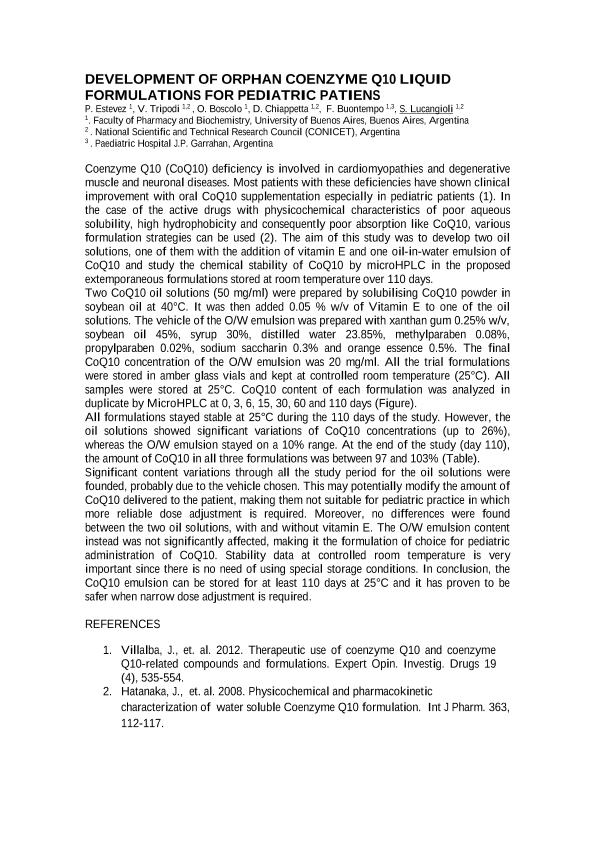Mostrar el registro sencillo del ítem
dc.contributor.author
Estevez, Pablo Nicolas
dc.contributor.author
Tripodi, Valeria Paula

dc.contributor.author
Boscolo, O.
dc.contributor.author
Chiappetta, Diego Andrés

dc.contributor.author
Buontempo, Fabian

dc.contributor.author
Lucangioli, Silvia Edith

dc.date.available
2015-09-03T16:04:19Z
dc.date.issued
2013-08
dc.identifier.citation
Estevez, Pablo Nicolas; Tripodi, Valeria Paula; Boscolo, O.; Chiappetta, Diego Andrés; Buontempo, Fabian; et al.; Development of orphan coenzyme q10 liquid formulations for pediatric patiens; Elsevier Science; European Journal Of Pharmaceutical Sciences; 8-2013; 69-70
dc.identifier.issn
0928-0987
dc.identifier.uri
http://hdl.handle.net/11336/1914
dc.description.abstract
Coenzyme Q10 (CoQ10) deficiency is involved in cardiomyopathies and degenerative muscle and neuronal diseases. Most patients with these deficiencies have shown clinical improvement with oral CoQ10 supplementation especially in pediatric patients (1). In the case of the active drugs with physicochemical characteristics of poor aqueous solubility, high hydrophobicity and consequently poor absorption like CoQ10, various formulation strategies can be used (2). The aim of this study was to develop two oil solutions, one of them with the addition of vitamin E and one oil-in-water emulsion of CoQ10 and study the chemical stability of CoQ10 by microHPLC in the proposed extemporaneous formulations stored at room temperature over 110 days.
Two CoQ10 oil solutions (50 mg/ml) were prepared by solubilising CoQ10 powder in soybean oil at 40°C. It was then added 0.05 % w/v of Vitamin E to one of the oil solutions. The vehicle of the O/W emulsion was prepared with xanthan gum 0.25% w/v, soybean oil 45%, syrup 30%, distilled water 23.85%, methylparaben 0.08%, propylparaben 0.02%, sodium saccharin 0.3% and orange essence 0.5%. The final CoQ10 concentration of the O/W emulsion was 20 mg/ml. All the trial formulations were stored in amber glass vials and kept at controlled room temperature (25°C). All samples were stored at 25°C. CoQ10 content of each formulation was analyzed in duplicate by MicroHPLC at 0, 3, 6, 15, 30, 60 and 110 days (Figure).
All formulations stayed stable at 25°C during the 110 days of the study. However, the oil solutions showed significant variations of CoQ10 concentrations (up to 26%), whereas the O/W emulsion stayed on a 10% range. At the end of the study (day 110), the amount of CoQ10 in all three formulations was between 97 and 103% (Table).
Significant content variations through all the study period for the oil solutions were founded, probably due to the vehicle chosen. This may potentially modify the amount of CoQ10 delivered to the patient, making them not suitable for pediatric practice in which more reliable dose adjustment is required. Moreover, no differences were found between the two oil solutions, with and without vitamin E. The O/W emulsion content instead was not significantly affected, making it the formulation of choice for pediatric administration of CoQ10. Stability data at controlled room temperature is very important since there is no need of using special storage conditions. In conclusion, the CoQ10 emulsion can be stored for at least 110 days at 25°C and it has proven to be safer when narrow dose adjustment is required.
dc.format
application/pdf
dc.language.iso
eng
dc.publisher
Elsevier Science

dc.relation
Congreso; 5th International BBBB Conference; The European Federation for Pharmaceutical Sciences;2013
dc.rights
info:eu-repo/semantics/openAccess
dc.rights.uri
https://creativecommons.org/licenses/by-nc-sa/2.5/ar/
dc.subject
Coenzyme Q10
dc.subject
Orphan Formulation
dc.subject
Pediatrics
dc.subject.classification
Otras Ciencias de la Salud

dc.subject.classification
Ciencias de la Salud

dc.subject.classification
CIENCIAS MÉDICAS Y DE LA SALUD

dc.title
Development of orphan coenzyme q10 liquid formulations for pediatric patiens
dc.type
info:eu-repo/semantics/article
dc.type
info:ar-repo/semantics/artículo
dc.type
info:eu-repo/semantics/publishedVersion
dc.date.updated
2015-08-14T18:18:32Z
dc.journal.pagination
69-70
dc.journal.pais
Países Bajos

dc.journal.ciudad
Amsterdam
dc.description.fil
Fil: Estevez, Pablo Nicolas. Universidad de Buenos Aires. Facultad de Farmacia y Bioquimica. Departamento de Tecnologia Farmaceutica; Argentina
dc.description.fil
Fil: Tripodi, Valeria Paula. Universidad de Buenos Aires. Facultad de Farmacia y Bioquimica. Departamento de Tecnologia Farmaceutica; Argentina. Consejo Nacional de Investigaciones Científicas y Técnicas; Argentina
dc.description.fil
Fil: Boscolo, O.. Universidad de Buenos Aires. Facultad de Farmacia y Bioquimica. Departamento de Tecnologia Farmaceutica; Argentina
dc.description.fil
Fil: Chiappetta, Diego Andrés. Universidad de Buenos Aires. Facultad de Farmacia y Bioquimica. Departamento de Tecnologia Farmaceutica; Argentina. Consejo Nacional de Investigaciones Científicas y Técnicas; Argentina
dc.description.fil
Fil: Buontempo, Fabian. Universidad de Buenos Aires. Facultad de Farmacia y Bioquimica. Departamento de Tecnologia Farmaceutica; Argentina
dc.description.fil
Fil: Lucangioli, Silvia Edith. Consejo Nacional de Investigaciones Científicas y Técnicas; Argentina. Universidad de Buenos Aires. Facultad de Farmacia y Bioquimica. Departamento de Tecnologia Farmaceutica; Argentina
dc.journal.title
European Journal Of Pharmaceutical Sciences

Archivos asociados
